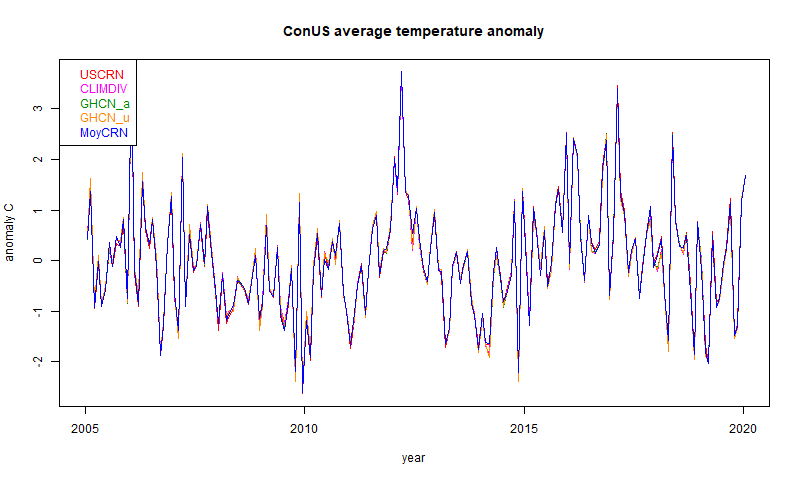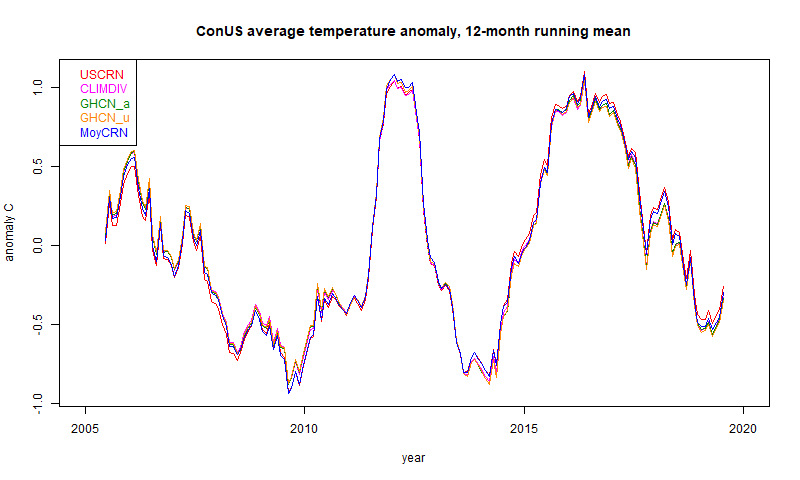Friday, March 13, 2020
GISS February global up by 0.09°C from January.
As usual here, I will compare the GISS and earlier TempLS plots below the jump.
Friday, March 6, 2020
USA Temperatures; comparison of Moyhu results with NOAA.

They are so close that the differences are hard to see. It is easier with a 12-month running mean, mainly because the y-axis doesn't have to cover such a large range:

You can see that they are still very close, with some small difference between CRN and the other data. I can quantify this with a table of standard deviation of differences (unsmoothed data):
| 2005-2019 | USCRN | CLIMDIV | GHCN_a | GHCN_u | MoyCRN |
| USCRN | 0 | 0.091 | 0.098 | 0.103 | 0.058 |
| CLIMDIV | 0.091 | 0 | 0.027 | 0.029 | 0.092 |
| GHCN_a | 0.098 | 0.027 | 0 | 0.01 | 0.096 |
| GHCN_u | 0.103 | 0.029 | 0.01 | 0 | 0.099 |
| MoyCRN | 0.058 | 0.092 | 0.096 | 0.099 | 0 |
| Trend | 3.103 | 1.957 | 1.958 | 1.76 | 2.616 |
The very close results are between GHCN adjusted and unadjusted. Here the stations and the methods are the same, so the only difference is the adjustment of the data. And it is very small. The difference between the GHCNs and NOAA's ClimDiv is larger, but still very small.
The two CRNs show a larger difference again, but the largest is between the CRN groups and the others. As I said in the last post, I don't think this reflects different accuracy of the stations; CRN are presumably better. It reflects the dominance of location uncertainty in the spatial averages. That is, how much spread would you see if you measured at different places. Or, how well do you real think the infilling represents the unmeasured regions. Of course, the different coverage gives a check; I showed in the last post a difference plot in one month between the sparse CRN and the dense ClimDiv.
I have also shown the trends, in °C/century. These are very uncertain on such a short period, and you might be surprised at their size, since the plot doesn't reflect that by eye. But a trend of 2 °C/Cen rises only 0.3°C in this period. The closeness reflects that shown in the sd table. I don't think much should be made of the fact that CRN shows a higher trend.
Over a longer period, the CRN results do not cover, and the other data diverge more. The different adjustment policies start to show. Here is the period since 1900. I'm now using a 5 year running mean to make the differences clearer:

Now there is an obvious difference between the adjusted and unadjusted. My GHCN_a still agrees quite well with ClimDiv. Again the differences can be quantified in the reduced table of standard deviations:
| 1900-2019 | CLIMDIV | GHCN_a | GHCN_u |
| CLIMDIV | 0 | 0.064 | 0.257 |
| GHCN_a | 0.064 | 0 | 0.23 |
| GHCN_u | 0.257 | 0.23 | 0 |
| Trend | 0.84 | 0.828 | 0.371 |
The trends (in °C/Cen) again tell the story. Adjustment makes a big difference, as was noted back in USHCN V1. USHCN did both homogenisation and explicit TOBS adjustment, and I believe ClimDiv, which replaced it, does the same. GHCN relies on the pairwise homogenisation to cover the TOBS effect, and on this accounting it seems to do that very well.
Of course, some would say that this means that more than half the (modest) ConUS warming is created by adjustments. The proper scientific view is that unadjusted readings had a spurious cooling bias, which should be corrected. The sources of this are real and known:
- TOBS - it makes a substantial difference whether daily reading of a a min-max thermometer is done in the afternoon, where it tends to double-count warm days, or in the morning, where it double counts cool minima. The times of reading are known, and the pettern is a shift toward morning reading. This is a quantifiable cooling bias, and must be adjusted for. It isn't optional.
- Measurement changes - firstly improved screening, and then MMTS, both produced lower readings. These can be identified as abrupt changes relative to neighbours, and again must be corrected.
Next steps
I plan to set this analysis up as a regular calculation, as with TempLS global, and post the results on the data page. I have now done a similar analysis for Australia, which I'll also write about. I'll also work on a page of maps of past months, and possibly seasons and years.Thursday, March 5, 2020
February in ConUS - surface anomalies mostly warm - new graphics.
This post follows one here where I described a new way of calculating an average temperature for a region like ConUS (USA, lower 48 states) and showed comparative graphics for January 2020. I use GHCN V4 data, and there is now enough out to do a February post. It was warm like January, in most parts. I'll link below to a set of numerical data for ConUS for all months since 1900.
I use 2005-2019 as the base period for anomalies, to make possible comparison with USCRN. But I won't show USCRN here, because the greater station numbers in GHCN give a better result. Probably in production I'll revert to the WMO base of 1981-2010. I use GHCN unadjusted here; visually, it makes no difference. Here is the result for February 2020:

I realised that I could also usefully compare this graphic with the WebGL global plots that I show as the data comes in. These are the most detailed early depictions of the data. Here is a zoomed extract from that source:

Both plots have the property that the color at each station is correct at that point, and elsewhere is interpolated. The WebGL plot is based on triangular mesh with linear interpolation; the new plot uses the Laplace infilling, which is smoother.
Next I'll show the corresponding plots for 2019. At some stage I'll set up a page which goes back further. This one is done in the usual style where the buttons below let you cycle through the months.
Historical results and comparisons.
I'll post soon with an analysis of comparison with other data. I'll post a link to the table here. The table shows the NOAA data for ClimDiv and USCRN, and my corresponding averages using data from GHCN V4 adjusted, unadjusted and USCRN. All results have been set to anomaly base 2005-2018.
Wednesday, March 4, 2020
February global surface TempLS up 0.053°C from January.
The prominent feature, as with January, was a huge band of warmth stretching from Europe through to E Siberia and China. Again N America was also warm, except for Alaska (cold). Greenland and the Arctic archipelago were also cool. Africa and S America were mostly warm, Antarctica mixed.
Here is the temperature map, using the LOESS-based map of anomalies.
 As always, the 3D globe map gives better detail.
As always, the 3D globe map gives better detail.Tuesday, March 3, 2020
NCEP/NCAR reanalysis monthly surface temperature unchanged in February 2020.
As with January, the main feature was a band of warmth from Europe right across Russia and Siberia. Again there was a complementary cold band across Arctic North America and Greenland. Elsewhere mixed, with cool seas around S America, and a cool region in the Sahara.












